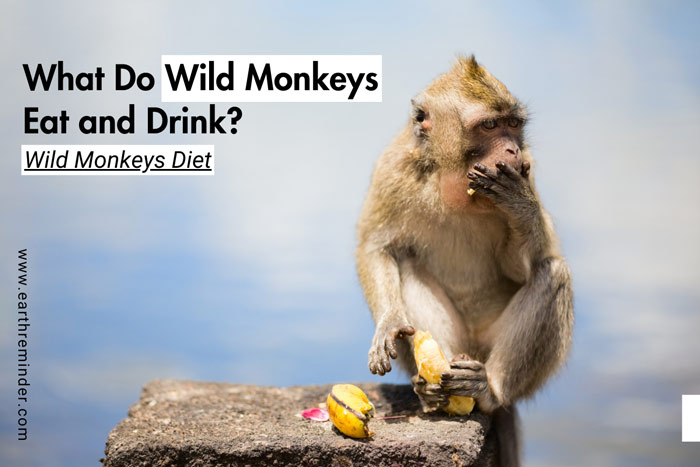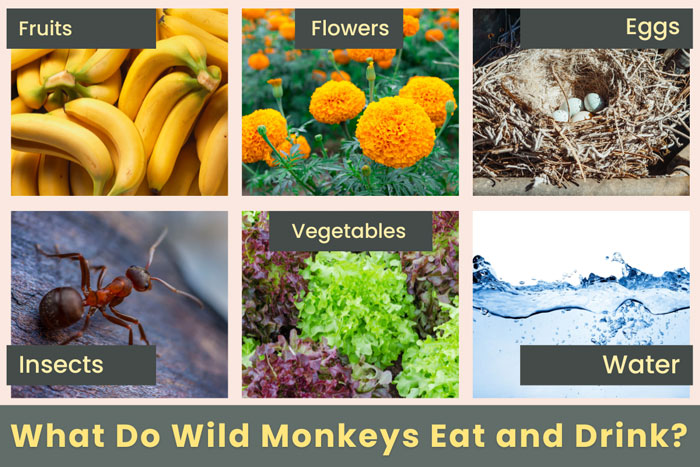What Do Wild Monkeys Eat and Drink? – Wild Monkeys Diet
Wild monkeys are omnivorous species that eat a wide range of foods based on their habitat and also from the resources that are accessible. Fruits, leaves, flowers, insects, and small animals, are all part of their diet. A monkey’s preferred foods might change depending on its location, climate, and social habits. As among the most adaptable and diverse groups of primates in the world, monkeys are known for their willingness to forage for food in their natural habitat. We will examine the various foods wild monkeys consume in this post and how their diets help ensure their survival and general well-being in the wild.
Table of Contents
Where Do Monkeys Find Their Food?
Monkeys make use of the nearby habitat for food they’re able to consume as well as digest. Monkeys can find food in forests, grasslands, and near water, depending on the species and where they live. Everything that has generally been simple for them to access and provides quick access to sugar, fruit, fiber, carbohydrates, and animal protein is their meal. The finding pattern of old-world monkeys and new-world monkeys can be understood in the following manner:
Old World Monkeys: Old World monkeys search for food in trees and on the ground in forests. Some types also look for food in grasslands. They might eat plants and small animals near rivers and water sources. Old-world monkeys and apes have opposable thumbs that make it easier for the smaller monkeys to swing from one tree to the next and for them to grasp and eat fruit. Also, not all species of monkeys have opposable thumbs. They can also eat on the ground. Old-world monkeys use unique cheek pouches to store food because they travel a lot for their daily diet. Some types of monkeys store food for later use. Others hunt for small creatures like insects, lizards, snails, and frogs.
New World Monkeys: The monkeys usually stay in the trees in the rainforest to find food. The New World monkeys also find food in swamps and wetlands. A few types live in mountain regions and eat trees or bushes. Capuchin monkeys are smart new world monkeys that are seen utilizing rocks or tools to obtain difficult food, such as hard-shelled nuts, ants, termites, and other insects.
Also, both monkey species go near humans to find food, but this isn’t their natural food so it could be dangerous for them.
What Do Monkeys Eat In The Wild?
The diverse group of primates known as monkeys can be found worldwide. Based on their species as well as the environment they live in, their eating habits can change. Let’s examine what monkeys consume in the wild in more detail:
Fruits And Seeds
The majority of monkeys eat fruits and seeds because they love them. From a nutritional point of view, fruits give monkeys energy and vitamins. Seeds are also good for them because they provide fats and proteins. They can consume various fruits, such as berries, figs, bananas, and mangoes. Monkeys in the wild eat fruits and seeds from trees and the ground.
Leaves And Flowers
Monkeys also consume the vital elements found in leaves and flowers. The unique stomachs of some monkey species enable them to digest leaves more effectively. Some monkeys, for example, howler monkeys and colobus monkeys, mainly eat leaves. They get fiber and nutrients from leaves. Flowers supply nectar and pollen to monkeys to eat. The nectar in flowers gives monkeys quick energy.
Insects And Small Animals
There are monkeys that eat insects and small mammals, like capuchin and macaque monkeys. They can hunt for insects both on the ground, under rocks, and in trees, like termites, spiders, and ants. Their agility and razor-sharp claws enable them to capture other tiny creatures, including lizards and birds. They also eat birds eggs. All of them have protein and other essential nutrients that monkeys need.
Human Food
Sadly, many urban monkeys eat human food now. They can steal food from people and scavenge food from trash cans. Usually, this happens near tourist spots or towns where humans live. In the wild, monkeys can’t eat human food because it’s not naturally available. It can make them sick and cause problems. All of us should let monkeys eat what they naturally find.
“Remember every animal is important. Check out the importance of animals to humans and the environment here.”
Now let’s discuss below some of the questions that are frequently asked about Capuchin monkeys, Sea monkeys, and Squirrel monkeys:
What Do Capuchin Monkeys Eat in The Wild?
In the wild, capuchin monkeys have a diverse diet. They are omnivores. A capuchin is known to eat cumare and manikara fruit from palm trees. Bananas, berries, and seeds are also their favorites. Also, they look for insects under rocks or in trees. They get protein from insects. In some cases, they even consume small animals like lizards, birds, and other small animals. It doesn’t happen very often, but it does.
What Do Sea Monkeys Eat in The Wild?
Sea monkeys are actually brine shrimp, not real monkeys. It’s a marketing name for brine shrimp that’s sold as aquarium pets. They eat microscopic algae and phytoplankton in the wild. They get nutrients from these small food items.
What Do Squirrel Monkeys Eat in The Wild?
Wild squirrel monkeys mostly eat fruits. Their energy and vitamins come from fruits like berries and apples. They also eat bugs like ants and spiders. They get protein from them. In some cases, they’ll eat leaves or small animals. The also eat onions, celery, and lettuce as vegetables.
What Do Wild Monkeys Drink?
The majority of monkeys and apes are mostly dependent on land-based water sources, such as lakes, rivers, or even other water sources. Also, they consume enough water through their meals to meet their daily needs.
Yet, primates occasionally turn to alternative water sources, including those gathered in tree holes, to quench their thirst. Most of the water wild monkeys consume comes from the fruits, leaves, and insects they consume as food. They may occasionally also suck dew or precipitation off plants to get water.
What Do Wild Monkeys Not Like to Eat?
Sarpgandha, Brahmi, Ashwagandha, Shatavari, Kalmegh, Tulsi, Aloe vera, Artemisia, and other medicinal plants are all unappealing to monkeys. Yet, some foods are avoided or not consumed by wild monkeys. They’re as follows:
Meat
As we discussed above some monkeys eat insects, spiders, and small mammals like birds. But most wild monkeys tend to be herbivores, which means they primarily consume items that come from plants, such as fruits, leaves, flowers, and nuts. They don’t eat chicken or fish. So, meat is normally not a significant part of their diet for most monkey species.
Toxic Plants
The monkeys learn what to eat from their family and group. Younger monkeys learn which foods are safe from older ones. Wild monkeys can generally tell which plants are poisonous and which are safe to eat. Monkeys sometimes smell or taste plants before eating them. To avoid poisoning, they usually stay away from poisonous plants. For example, Angel’s Trumpet and Devil’s Trumpet are poisonous to monkeys.
Certain Fruits
Even though many monkeys are frugivores and consume a wide range of fruits, some fruits may not be consumed by all of them. This is due to their flavor, texture, and toxicity. For instance, some monkeys shy away from sour or bitter fruit, while others might not consume fruit with a hard, thick peel. Similarly, fruits from the Manchineel tree are toxic. These seem to be avoided by monkeys.
“A monkey’s diet makes them both primary and secondary consumers. You can learn more about how energy flows within an ecosystem here.”
Conclusion
The diet of wild monkeys varies depending on species and environment, including the availability of food sources. Wild monkeys typically consume various foods, including fruits, seeds, leaves, flowers, insects, and small animals. Aside from that, some species may eat bark, sap, and even dirt. Also, some food may only be available at certain times of the year, so wild monkeys’ diets may also change seasonally. In a nutshell, wild monkeys have evolved a versatile diet and adapted to their habitats to survive in the wild.

